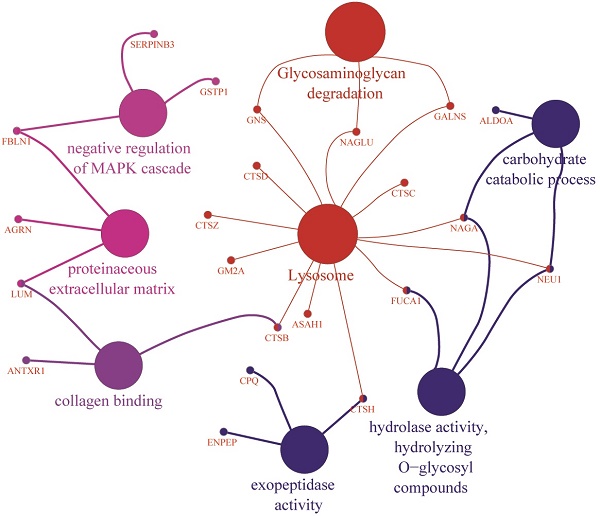当前位置:
X-MOL 学术
›
Theranostics
›
论文详情
Our official English website, www.x-mol.net, welcomes your
feedback! (Note: you will need to create a separate account there.)
Therapeutic Effect of Astroglia-like Mesenchymal Stem Cells Expressing Glutamate Transporter in a Genetic Rat Model of Depression
Theranostics ( IF 12.4 ) Pub Date : 2017-07-06 , DOI: 10.7150/thno.18914 Amit Shwartz , Oshra Betzer , Noam Kronfeld , Gila Kazimirsky , Simona Cazacu , Susan Finniss , Hae Kyung Lee , Menachem Motiei , Shani Yael Dagan , Rachela Popovtzer , Chaya Brodie , Gal Yadid
Theranostics ( IF 12.4 ) Pub Date : 2017-07-06 , DOI: 10.7150/thno.18914 Amit Shwartz , Oshra Betzer , Noam Kronfeld , Gila Kazimirsky , Simona Cazacu , Susan Finniss , Hae Kyung Lee , Menachem Motiei , Shani Yael Dagan , Rachela Popovtzer , Chaya Brodie , Gal Yadid

|
Recent studies have proposed that abnormal glutamatergic neurotransmission and glial pathology play an important role in the etiology and manifestation of depression. It was postulated that restoration of normal glutamatergic transmission, by enhancing glutamate uptake, may have a beneficial effect on depression. We examined this hypothesis using unique human glial-like mesenchymal stem cells (MSCs), which in addition to inherent properties of migration to regions of injury and secretion of neurotrophic factors, were differentiated to express high levels of functional glutamate transporters (excitatory amino acid transporters; EAAT). Additionally, gold nanoparticles (GNPs), which serve as contrast agents for CT imaging, were loaded into the cells for non-invasive, real-time imaging and tracking of MSC migration and final location within the brain. MSC-EAAT (2×105; 10 μl) were administered (i.c.v.) to Flinder Sensitive Line rats (FSLs), a genetic model for depression, and longitudinal behavioral and molecular changes were monitored. FSL rats treated with MSC-EAAT showed attenuated depressive-like behaviors (measured by the forced swim test, novelty exploration test and sucrose self-administration paradigm), as compared to controls. CT imaging, Flame Atomic Absorption Spectroscopy analysis and immunohistochemistry showed that the majority of MSCs homed specifically to the dentate gyrus of the hippocampus, a region showing structural brain changes in depression, including loss of glial cells. mRNA and protein levels of EAAT1 and BDNF were significantly elevated in the hippocampus of MSC-EAAT-treated FSLs. Our findings indicate that MSC-EAATs effectively improve depressive-like manifestations, possibly in part by increasing both glutamate uptake and neurotropic factor secretion in the hippocampus.
中文翻译:

表达谷氨酸转运蛋白的星形胶质样间充质干细胞在抑郁症成年大鼠模型中的治疗作用
最近的研究表明,异常的谷氨酸能神经传递和神经胶质病理在抑郁症的病因和表现中起着重要作用。据推测,通过增加谷氨酸的摄取来恢复正常的谷氨酸能传递可能对抑郁症具有有益的作用。我们使用独特的人类神经胶质样间充质干细胞(MSCs)检验了这一假设,该细胞除了具有迁移到损伤区域和分泌神经营养因子的固有特性外,还可以表达高水平的功能性谷氨酸转运蛋白(兴奋性氨基酸转运蛋白)。 ; EAAT)。此外,将金纳米颗粒(GNP)(用作CT成像的造影剂)加载到细胞中,以进行非侵入性实时成像并跟踪MSC在大脑中的迁移和最终定位。5; 向Flinder敏感系大鼠(FSLs)施用(icv)10μl,建立抑郁症的遗传模型,并监测纵向行为和分子变化。与对照组相比,用MSC-EAAT治疗的FSL大鼠表现出减弱的抑郁样行为(通过强迫游泳试验,新奇探索试验和蔗糖自我给药范例测量)。CT成像,火焰原子吸收光谱分析和免疫组织化学分析显示,大多数MSCs特定地归巢于海马的齿状回,该区域显示出抑郁中脑部结构的变化,包括神经胶质细胞的丢失。MSC-EAAT处理的FSL的海马中EAAT1和BDNF的mRNA和蛋白水平显着升高。我们的发现表明,MSC-EAAT有效改善了抑郁症样表现,
更新日期:2017-10-01
中文翻译:

表达谷氨酸转运蛋白的星形胶质样间充质干细胞在抑郁症成年大鼠模型中的治疗作用
最近的研究表明,异常的谷氨酸能神经传递和神经胶质病理在抑郁症的病因和表现中起着重要作用。据推测,通过增加谷氨酸的摄取来恢复正常的谷氨酸能传递可能对抑郁症具有有益的作用。我们使用独特的人类神经胶质样间充质干细胞(MSCs)检验了这一假设,该细胞除了具有迁移到损伤区域和分泌神经营养因子的固有特性外,还可以表达高水平的功能性谷氨酸转运蛋白(兴奋性氨基酸转运蛋白)。 ; EAAT)。此外,将金纳米颗粒(GNP)(用作CT成像的造影剂)加载到细胞中,以进行非侵入性实时成像并跟踪MSC在大脑中的迁移和最终定位。5; 向Flinder敏感系大鼠(FSLs)施用(icv)10μl,建立抑郁症的遗传模型,并监测纵向行为和分子变化。与对照组相比,用MSC-EAAT治疗的FSL大鼠表现出减弱的抑郁样行为(通过强迫游泳试验,新奇探索试验和蔗糖自我给药范例测量)。CT成像,火焰原子吸收光谱分析和免疫组织化学分析显示,大多数MSCs特定地归巢于海马的齿状回,该区域显示出抑郁中脑部结构的变化,包括神经胶质细胞的丢失。MSC-EAAT处理的FSL的海马中EAAT1和BDNF的mRNA和蛋白水平显着升高。我们的发现表明,MSC-EAAT有效改善了抑郁症样表现,











































 京公网安备 11010802027423号
京公网安备 11010802027423号